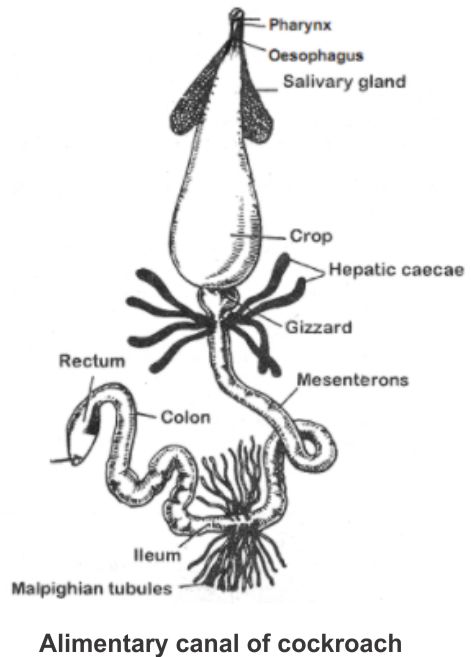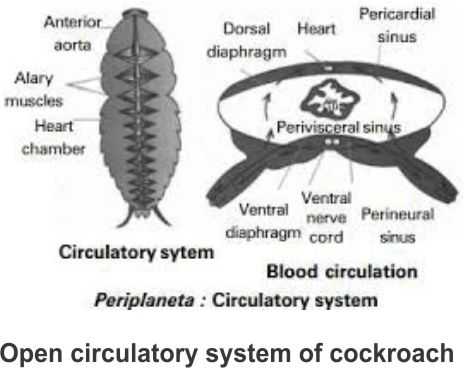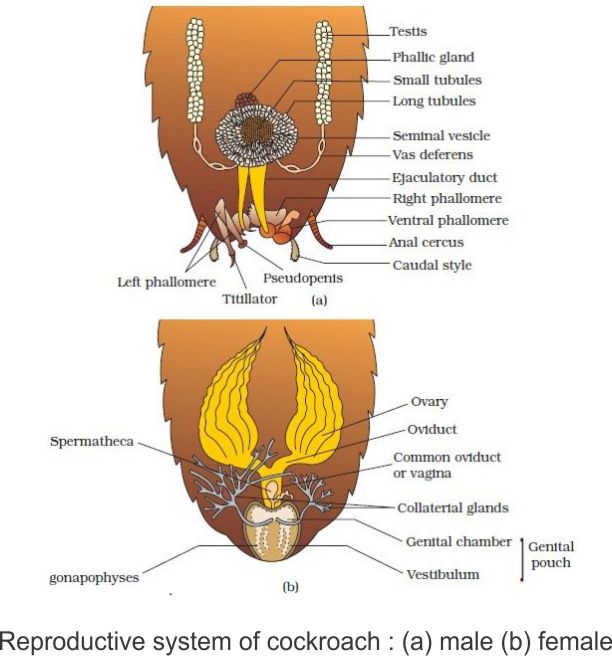Anatomy of Cockroach
1. Body Structure:
- Cockroaches are brown or black insects belonging to the class Insecta in Phylum Arthropoda. They have a size ranging from ¼ inches to 3 inches (0.6-7.6 cm).
- They possess long antennae, legs, and a flat upper body wall that conceals the head.
2. Digestive System:
- The alimentary canal of a cockroach is divided into three regions: foregut, midgut, and hindgut.
- The mouth leads to the pharynx and then the oesophagus, followed by a crop used for food storage. Next is the gizzard, which grinds food particles.
- Hepatic or gastric caecae secrete digestive juices at the junction of the foregut and midgut.
- Malphigian tubules, numbering 100-150, are present at the junction of the midgut and hindgut and help in excretion.
- The hindgut is divided into ileum, colon, and rectum, with waste expelled through the anus.

3. Circulatory System:
- The blood vascular system in cockroaches is an open type. Blood vessels open into a space known as the haemocoel, where visceral organs are bathed in haemolymph.
- Haemolymph consists of colorless plasma and haemocytes.
- The heart of a cockroach is an elongated muscular tube with chambers and ostia on either side. It pumps blood anteriorly to the sinuses.

4. Respiratory System:
- Cockroaches have a network of trachea, which opens through 10 pairs of small holes known as spiracles on the lateral side of the body.
- Thin branching tubes (tracheoles) carry oxygen to different body parts, and sphincters regulate the opening of spiracles.
5. Excretory System:
- Excretion is primarily performed by Malpighian tubules, which absorb nitrogenous waste products and convert them into uric acid. Therefore, this insect is called uricotelic.
- Fat body, nephrocytes, and urecose glands also aid in excretion.
- The nervous system of a cockroach consists of a series of fused, segmentally arranged ganglia joined by paired longitudinal connectives on the ventral side.
- In the head, the brain is represented by the supra-oesophageal ganglion, which supplies nerves to antennae and compound eyes.
- Sense organs in cockroaches include antennae, eyes, maxillary palps, labial palps, and anal cerci.
- Compound eyes consist of numerous hexagonal ommatidia, contributing to mosaic vision with sensitivity but less resolution.
- Cockroaches are dioecious, with well-developed reproductive organs in both sexes.
- The male reproductive system includes testes, vas deferens, seminal vesicles, ejaculatory duct, and male gonopore.
- A mushroom-shaped gland functions as an accessory reproductive gland.
- The female reproductive system comprises ovaries, ovarian tubules, oviducts, spermatheca, and the formation of oothecae for egg deposition.
- Cockroaches reproduce through spermatophores, and the nymphs (immature stage of cockroaches) grow by molting until they reach the adult stage.
